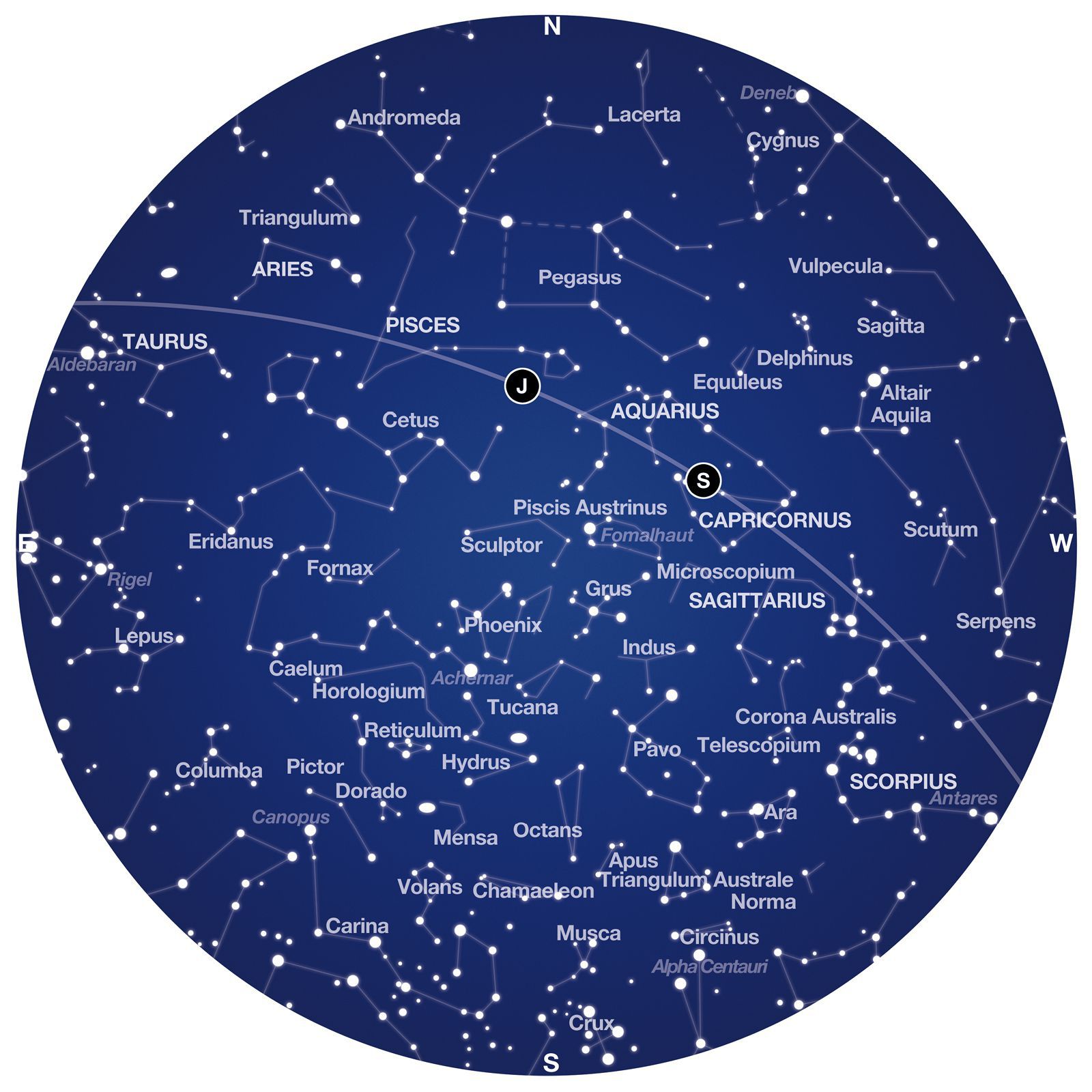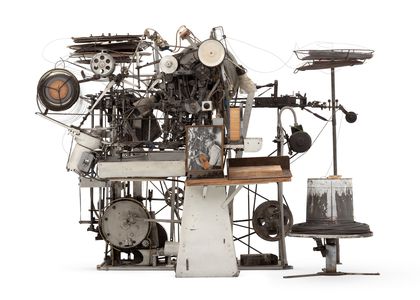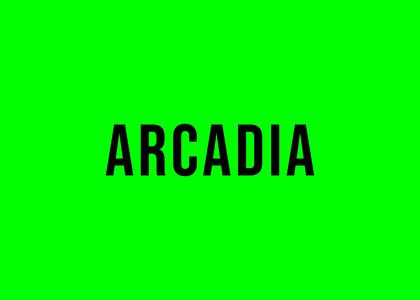
Monthly sky maps from the 2022 Australasian Sky Guide by Dr Nick Lomb, published by MAAS Media.
What’s in the sky this November?
Constellations
Constellations are groups of stars that form a picture. These pictures were given names and for millennia have been used as a tool for navigation and to share significant cultural stories. Astronomers use these constellations to delineate portions of the sky and as a way for locating astronomical objects. In November the following constellations dominate the spring sky:
- Pegasus – the winged horse is high in the northern sky. Pegasus is easy to find, with the best-known feature of this constellation the ‘Great Square of Pegasus’. The Square is large at over 15 degrees in width and 13 degrees in height however, there are few bright stars within the Square making it easy to locate. Four stars outline the Square and in the past all four were a part of the constellation, however delta Pegasi is now known as Alpha Andromedae.
- Andromeda – low in the northern sky beneath Pegasus. While best seen in the northern hemisphere, a clear view to the north horizon allows southern observers to explore this constellation.
- Aquarius – high overhead in the November sky. An ancient constellation, Aquarius is best known for the Eta-Aquarids meteor shower that peaks in early May. Like the other constellations, Aquarius is steeped in mythology, seen as Ganymede, a shepherd boy in Greek mythology and as a man pouring water from a jug by the Babylonians.
- Cetus – high in the eastern sky and one of the most ancient and the fourth largest constellation in our sky. Cetus is depicted as a variety of creatures, including a sea monster and a whale. It is found in the sky beside Eridanus, the river.
- Eridanus – stretching high across the southern evening sky. Eridanus represents a river with the beginning near the constellation of Orion and the end of the river marked by the brilliant Achernar, a blue-white star shining at magnitude 0.5.
Planets
Jupiter and Saturn are joined in the evening sky by Mars and late in the month by Venus and Mercury.
- Mercury – a good view to the horizon is needed to see Mercury, low in the south-western twilight sky, a few degrees above Venus, at the end of the month.
- Venus – visible at the end of the month, low in the south-western twilight sky in the constellation Ophiuchus. A clear view to the horizon will aid in observing Venus this month.
- Mars – is rising in the north-eastern sky, late in the evening at the start of the month but by month’s end is rising less than an hour after sunset. On the 11th, the waning gibbous Moon rises just after Mars and is below and slightly to the left (north) of the red planet.
- Jupiter – the largest planet in our Solar System, is high in the northern sky after sunset in the constellation Pisces. On the 4th the waxing gibbous Moon is above and to the left (west) of the gas giant while on the 5th, the Moon is below and to the right (east).
- Saturn – the ringed planet is high in the north-western sky after sunset in the constellation Capricornus. On the 1st, the first quarter Moon is above and to the left (west) of Saturn and on the 29th, the narrow waxing crescent Moon is above the planet.
Moon
First Quarter is on Tuesday 1st
Full Moon is on Tuesday 8th
Last Quarter is on Thursday 17th
New Moon is on Thursday 24th
Deep Sky
Explore the universe through binoculars or a telescope and take in these gems of the November sky:
- LMC/SMC – The Large and Small Magellanic Clouds are the two satellite galaxies of our own Milky Way. The Large Magellanic Cloud (LMC) is in the constellation of Dorado and is about 160,000 light years away, while the Small Magellanic Cloud (SMC) is in Tucana and is about 200,000 light years away.
- 47 Tuc or 47 Tucana (NGC 104) – is one of the finest globular clusters in the sky, second only to Omega Centauri. It sits beside the SMC in the constellation Tucana and can be seen away from city lights with the unaided eye. 47 Tuc is approximately 15,000 light years from us.
- Tarantula Nebula (NGC 2070) – a large hydrogen gas cloud approximately 1,000 light years in diameter and is part of the LMC. The name ‘Tarantula’ comes from the spider-like appearance of the nebula in telescopes and photographs. At the centre of the nebula is the open cluster R136, which contains approximately 500,000 stars that are some of the hottest and most massive supergiant stars known.
- M15 – the first globular cluster found to contain a planetary nebula is located in the constellation Pegasus. A rare intermediate black hole also resides at the centre of M15 and is thought to be 4,000 times the mass of our Sun. M15 lies about 33,600 light years from us and is best seen through binoculars or a telescope.
- NGC 6752 – is a bright (magnitude 6) globular cluster located in the constellation Pavo. Containing over 100,000 stars it is about 15,000 light years away.
- Saturn Nebula (NGC 7009) – a planetary nebula in Aquarius approximately 3,000 light years away. It is known as the Saturn Nebula due to its shape (resembling the planet Saturn) and at magnitude 8, it appears as a bluish ellipse in telescopes.
- M2 – is a globular cluster in Aquarius approximately 37,000 light years away. It contains over 150,000 stars and has a diameter of over 150 light years making it one of the largest known globular clusters. At magnitude 6.3, M2 can be easily seen in binoculars or a telescope.
- Andromeda Galaxy (M31) – is the most distant object visible to the unaided eye and is about 2.5 million light years away. While a fascinating sight with just your eyes, if you have binoculars or a small telescope then you will see the dark dust lanes of the spiral arms, a bright core, and if you are lucky you might pick up one or both of its companion galaxies.
Other Events
In November 2022 also look for:
- Total Lunar Eclipse – On the evening of November 8, a total lunar eclipse will be visible across Australia and New Zealand. The best views of the entire eclipse will be from New Zealand and along the east coast of Australia, with all capital/main cities across both countries except for Perth, Western Australia, seeing the full one hour, 26 minutes of totality. The Moon will rise at 7:19pm (AEDT) with the partial eclipse starting at 8:09pm (AEDT). Totality will be from 9:16pm to 10:42pm (AEDT) and during this time the Moon will take on a coppery-red hue. After totality the Moon moves out of the Earth’s shadow and the partial eclipse ends at 11:49pm (AEDT). You do not need any special equipment to see the eclipse – just your eyes and clear skies!
Learn More
- Purchase the 2023 Australasian Sky Guide by Dr Nick Lomb, featuring an annual report of what’s in the sky and the latest astronomical findings. Produced by MAAS Media.
- View the November Sky Chart, which shows the stars, constellations and planets visible in the night sky from anywhere in Australia
- Check out these resources for getting started.


